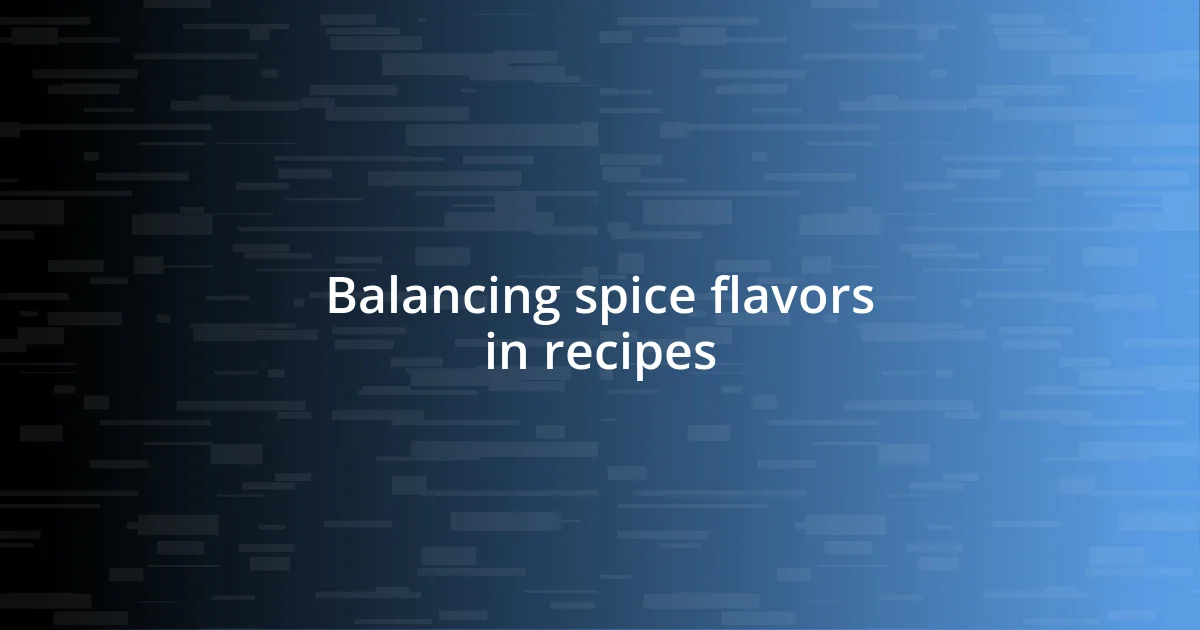Key takeaways:
- Spices like turmeric, cinnamon, and cloves provide significant health benefits, including anti-inflammatory and antioxidant properties.
- Proper storage techniques, such as using airtight containers and keeping spices away from heat and light, enhance their flavor and longevity.
- Timing and experimentation in using spices can transform a dish; adding spices early deepens flavor while finishing with fresh herbs creates a vibrant finish.

Understanding spices and their benefits
Spices are not just flavor enhancers; they are powerhouses of health benefits. I remember the first time I tried turmeric in my cooking—my skepticism faded as I discovered its anti-inflammatory properties, which made my joints feel more agile. Isn’t it fascinating how something as simple as a sprinkle of spice can transform our wellbeing?
Take cinnamon, for example. It’s a staple in my morning oatmeal, and it’s also known for its ability to help regulate blood sugar levels. I often think about how these everyday ingredients can provide such wide-ranging health benefits. What would happen if we all gave more thought to incorporating spices into our diets?
The antioxidants found in many spices, like cloves and oregano, work wonders in combatting oxidative stress in our bodies. I can genuinely feel the difference when I add these spices to my meals. It’s like seasoning not just for the palate but for my overall vitality. Why not explore these flavors and their health perks? What have you got to lose?

Choosing the right spices for dishes
Choosing the right spices for your dishes can truly elevate your culinary experience. I often walk through the spice aisle, and it’s like being in a treasure trove where each jar holds a world of unique flavors and aromas. For instance, when making a hearty stew, I have found that adding smoked paprika brings a rich, smoky depth that really brings the dish to life. It’s all about balancing flavors; think about how a touch of cayenne can provide a delightful kick against the backdrop of creamy potato soup.
When pairing spices with specific ingredients, personal preference plays a significant role. For example, my love for fresh basil in pasta dishes is grounded in its ability to brighten up the flavors, while bold spices like cumin work wonders in my favorite chili recipe. I encourage you to experiment with these combinations. What’s the worst that could happen? You might just stumble upon a winning combination that takes your meal to the next level.
Here’s a handy comparison of spices and their ideal pairings that I’ve compiled over time. It helps me decide quickly when I’m planning meals. I find that having this little cheat sheet makes cooking more spontaneous and fun!
| Spice | Best Used With |
|---|---|
| Smoked Paprika | Stews, Roasted Vegetables |
| Cumin | Chili, Roasted Meats |
| Basil | Pasta, Caprese Salad |
| Cinnamon | Oatmeal, Sweet Baked Goods |
| Cayenne | Soups, Sauces |

How to properly store spices
Storing spices properly is essential to maintaining their flavor and potency. When I first started my spice journey, I made the mistake of keeping everything in my kitchen cupboard, where heat and light would sneak in. Now, I’m much more careful. I ensure my spices are stored in cool, dark places, which has genuinely made a difference in their freshness. It’s amazing how a little attention to detail can bring out the best in these flavorful ingredients.
Here are some key points to keep in mind for optimal spice storage:
- Use airtight containers: This keeps moisture and air out, preserving flavor.
- Choose dark glass or opaque containers: Light degrades spices over time.
- Keep away from heat sources: Avoid storing spices near your stove or oven.
- Label and date your spices: This helps track freshness and usage.
- Store whole spices over ground: Whole spices tend to retain their flavor longer.
By implementing these practices, I’ve found my spice collection not only lasts longer but tastes significantly better. It’s these small adjustments that can truly transform your cooking experience. Each time I reach for those perfectly stored herbs and spices, I feel a connection to the vibrant history of culinary traditions, which only enhances my cooking pleasure.

Techniques for using spices
When it comes to using spices effectively, timing can be just as important as the selection itself. I remember the first time I added spices at different stages of cooking; it felt like discovering a whole new approach to flavor. Adding spices early can help them release their essential oils and deepen the overall flavor, while finishing a dish with fresh herbs or a sprinkle of spice can create a vibrant, aromatic finish. It’s like painting on a canvas; each stroke at various times can create a masterpiece!
Another technique I love is to toast certain spices before adding them to my dishes. I can still feel the warmth and rich aroma wafting through the kitchen when I first tried this method. Toasting spices like cumin or coriander in a dry skillet amplifies their flavor, turning a simple meal into something extraordinary. Have you ever experienced that moment when the scent of toasted spices fills the air? It’s a small step that can make a world of difference.
For those adventurous souls out there, blending your own spice mixes can be incredibly rewarding. I recall experimenting with various combinations inspired by my favorite dishes. My homemade “taco seasoning” has become a staple, with smoked paprika, cumin, and a hint of cinnamon. It feels special to know I crafted a unique blend that perfectly complements my meals. Isn’t it fascinating how that simple act of mixing can bring a sense of ownership and creativity to cooking? It transforms a routine task into an exciting culinary exploration!

Balancing spice flavors in recipes
Balancing spice flavors in recipes can be a bit like conducting a symphony—each ingredient plays its own part. I remember one particularly ambitious dish where I added a pinch of cayenne too soon, and instead of a gentle warmth, my curry turned fiery! This taught me the value of pacing spices, allowing their flavors to build gradually rather than overpowering the dish from the start. It’s a delicate dance, but with practice, you learn to keep the spice harmony.
One effective method I often use is pairing spices that complement each other. For instance, blending cinnamon with chili powder brings out the best in both, striking a perfect balance between warmth and heat. I often ask myself, “What flavor profiles can I layer?” This simple question inspires me to explore unusual combinations, like combining smoky paprika with sweet garlic. The result is often exciting and unexpectedly delicious, pushing the boundaries of traditional cooking.
Lastly, keeping track of flavors while tasting as you go is vital. I had an instance where I was preparing a famous family recipe, and I mistakenly added too much nutmeg. It was a lesson in moderation! I now take a spoonful and assess how the spices meld together throughout the cooking process. This practice not only allows for adjustments but turns cooking into an interactive experience—one where I feel connected to each layer of flavor. Have you ever noticed how tasting mid-cooking transforms your perspective on the dish? It’s like unraveling a mystery, one bite at a time.

Common spice pairings to enhance meals
Exploring common spice pairings can truly elevate your meals, and I’ve had some delightful experiences along the way. For example, rosemary and garlic are a classic duo that instantly transports me back to family dinners. The aromatic blend adds a comforting layer to roasted meats and vegetables. I can’t help but wonder—have you ever noticed how certain spice combinations evoke memories? It’s magical how a simple pairing can create nostalgia through taste.
Another pairing I’ve fallen in love with is cardamom and ginger. The first time I steeped these two together in tea, I was taken aback by how they complemented each other so beautifully. The warmth of ginger paired with the floral notes of cardamom creates a flicker of excitement that invigorates the senses. I often ask myself, “What other profiles can I explore with these spices?” This curiosity opens new avenues in cooking, leading to surprising flavor adventures that keep me engaged in the kitchen.
Then there’s the vibrant combination of turmeric and black pepper. I remember experimenting with this pairing in a soup, where the pepper not only enhanced the turmeric’s color but also improved its absorption in the body. It’s a wonderful reminder that certain spices can work synergistically—do you have any favorite pairings that amplify your meals? The exploration of spice relationships can be an eye-opening journey, one that encourages us to play and innovate in our own cooking.

Tips for experimenting with spices
When it comes to experimenting with spices, I love starting small. One evening, I decided to sprinkle a bit of smoked sea salt onto my avocado toast. The moment I took a bite, I felt like the dish transformed entirely; it added depth and complexity. Have you ever thought about how a tiny change can make a significant impact? That single choice pushed me to try other unique toppings, allowing me to elevate even the simplest meals into culinary experiences.
Another tip I swear by is not being afraid to mix spices that aren’t typically paired together. One time, I added a dash of espresso powder to a spice rub for roasted vegetables. I was uncertain about how it would turn out, but to my delight, it created a rich, earthy flavor that took my dish to another level. It’s moments like these—where you step outside your comfort zone—that often lead to the most exciting discoveries. So, what bold combinations can you dream up in your kitchen?
Lastly, I’ve found that using spices at different stages of cooking can lead to varying outcomes. I once made a marinara sauce and added fresh basil at the start, but then, in another attempt, I added it at the end. The first version was more subdued, while the latter burst with freshness. It made me realize the importance of timing; spices can unveil different aspects of their flavors depending on when they’re added. When do you find yourself experimenting with timing in your dishes? Balancing these elements can truly unleash the potential of spices, creating a dynamic flavor profile that keeps you inspired.














